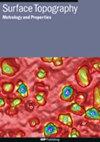Linearizing the vertical scale of an interferometric microscope and its effect on step-height measurement
IF 2
3区 材料科学
Q2 ENGINEERING, MECHANICAL
引用次数: 0
Abstract
The vertical scale calibration of an interferometric microscope is important for establishing traceability of surface topography measurements to the International System of Units (SI) unit of length, the meter. Building on the calibration procedure for the amplification coefficient developed by de Groot and Beverage [干涉显微镜垂直刻度的线性化及其对台阶高度测量的影响
干涉显微镜的垂直刻度校准对于建立表面形貌测量与国际单位制(SI)长度单位米的可追溯性非常重要。基于 de Groot 和 Beverage 开发的放大系数校准程序[Proc. SPIE9526, 952610 (2015)],本文介绍了一种校准程序,可生成相干扫描干涉显微镜整个垂直扫描运动的响应曲线。该方法只需要一个平面镜作为假象、一个窄带光谱滤波器、一个用于减小有效数值孔径的孔径以及升降显微镜头的能力,以便在扫描范围内改变干涉图的中心。干涉图的局部频率是通过将干涉图的部分拟合为正弦函数来确定的。根据局部频率数据确定的非线性度可用于估算未校正垂直高度测量值的不确定性。我们介绍了如何对光学剖面数据进行非线性校正,以消除扫描运动中的动态效应,并表明校正后的阶跃高度测量的重现性至少提高了三倍,重复性也接近三倍。
本文章由计算机程序翻译,如有差异,请以英文原文为准。
求助全文
约1分钟内获得全文
求助全文
来源期刊

Surface Topography: Metrology and Properties
Materials Science-Materials Chemistry
CiteScore
4.10
自引率
22.20%
发文量
183
期刊介绍:
An international forum for academics, industrialists and engineers to publish the latest research in surface topography measurement and characterisation, instrumentation development and the properties of surfaces.
 求助内容:
求助内容: 应助结果提醒方式:
应助结果提醒方式:


